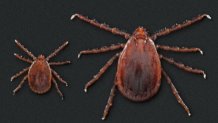Jamie Cantoni is walking through a dirt path. She is on a mission. Her entire body is covered in tick-repellent clothing. A white cloth drags behind her. Every several feet, she inspects the cloth closely.
"That is a female deer tick," she says as she holds up the cloth.
Cantoni is a research assistant at the Connecticut Agricultural Experiment Station (CAES). The white cloth she is holding attracts ticks. Last year Cantoni and her colleagues brought the cloth to 40 different locations across the state and collected more than 2,500 ticks to be studied.

The CAES received a one year grant from the Centers for Disease Control and Prevention last year to conduct a statewide surveillance program for ticks and tick borne diseases.
"I think the CDC's concern is that they are seeing an increase in the number of the reported tick borne disease cases," said Scott Williams, a scientist at the CAES. Williams called the data set that the surveillance effort provided "invaluable."
According to its website, the CDC estimates about 300,000 people get Lyme disease each year. A large portion of the cases are found in New England.
Local
The surveillance effort, which spanned spring summer and fall of 2019, allowed the team to get a better idea of what ticks are in the state, where they are and what percentage are infected.
According to the team at the CAES, the deer tick remains the most popular in Connecticut. Of the 2,500 ticks that were collected, 2,068 were deer ticks. Dog ticks made up 437 of the collection. They also identified two new emerging species in Connecticut. They found three lone star ticks in the sample size and, for the first time, recorded an Asian longhorned tick in New London County.
| DEER TICK | 2,068 |
| DOG TICK | 437 |
| LONE STAR TICK | 3 |
| ASIAN LONGHORNED TICK | 2 |
The highest average adult deer tick density was found in Fairfield County.
Once the field team, overseen by Williams, collected the ticks, they were studied in a lab at the CAES. The ticks were tested for five different disease-causing pathogens.
According to the data, 46 percent of all adult deer ticks collected (2,068) were infected with Lyme disease. The adult deer ticks also tested positive for babesiosis (13%), anaplasmosis (9%), hard tick relapsing fever (2%) and Powassan encephalitis (1%).
"You need to be vigilant about protecting yourself from the exposure to ticks," said Doug Brackney, an associate scientist who oversees the team that tests the ticks.
Williams explained that not only are more deer ticks being found infected with Lyme disease, less prevalent tick-borne diseases are also on the rise.
"They are kind of following the same trajectory as the Lyme disease pathogen," said Williams. "It is just advancing exponentially and we are seeing them creep up to the level of Lyme disease."

The new species of tick, Asian longhorned, found in New London County is known to host more on livestock than people. The tick is known to carry a dangerous disease in Asia, however no cases have been detected in the U.S.
"There is always the risk as, again, with climate change and the population starts to expand that there is more likelihood that we could see infections," said Brackney.
Brackney and Williams explained that because it has been a mild winter, the exposure time for tick borne illnesses has expanded.
"You are seeing increased survival through out the winter because it is so mild that you are seeing more of them make it through the winter," said Williams.
The CAES is still waiting to receive funding from the CDC to continue surveillance efforts for this year. Williams said that the data is not meant to create fear, but to inform.
"It is only getting worse. If we can be there with our finger on the pulse and document that change, we can maybe see some responses to it by health departments, federal government or something to maybe respond to this in some fashion," said Williams. "If nothing else, to document and educate the public on it."
They encourage people living in Connecticut to have exposure to ticks on their minds at all times, not just during a hike.
"There is always a risk," said Brackney.
The CDC created a Lyme disease prevention checklist, which includes checking your body for ticks, wearing tick repellent clothing and creating a tick-free zone in your yard.



